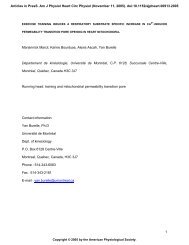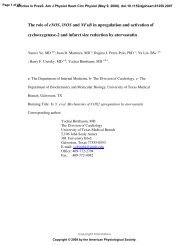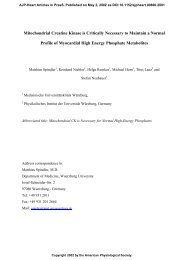Overexpression of 1B-adrenergic receptor induces left ventricular ...
Overexpression of 1B-adrenergic receptor induces left ventricular ...
Overexpression of 1B-adrenergic receptor induces left ventricular ...
Create successful ePaper yourself
Turn your PDF publications into a flip-book with our unique Google optimized e-Paper software.
-AR and 1-AR systems are integrated within the<br />
cardiomyocyte.<br />
The present transgenic model <strong>of</strong> cardiac-specific<br />
<strong>1B</strong>-AR overexpression has been previously analyzed by<br />
Akhter et al. (1). An increase in -AR kinase activity<br />
and the reduction <strong>of</strong> cAMP levels in transgenic membrane<br />
preparations supported the notion that -AR<br />
signaling is modulated by 1-AR. We were interested in<br />
the physiological consequences <strong>of</strong> cardiac <strong>1B</strong>-AR overexpression<br />
and have analyzed this model using both<br />
the anesthetized closed-chest mouse and the isolated<br />
work-performing perfusion preparation. We show here<br />
that the overexpression <strong>of</strong> <strong>1B</strong>-AR led to a dramatic<br />
basal level reduction in contractility that was correlated<br />
with a decrease <strong>of</strong> systolic Ca 2 transients. Stimulation<br />
<strong>of</strong> -AR restored most contractile parameters.<br />
However, perfused transgenic hearts were more sensitive<br />
to work load, indicating an impaired LV function.<br />
The functional changes occurred in the absence <strong>of</strong><br />
cardiac hypertrophy.<br />
MATERIALS AND METHODS<br />
RNA isolation and blots. The generation and initial characterization<br />
<strong>of</strong> the transgenic mice has been described previously<br />
(1). Animals were euthanized by CO 2 inhalation, and<br />
hearts were excised. Atria and vessels were dissected, and the<br />
ventricles were homogenized (Polytron, Brinkmann) directly<br />
in Trizol reagent (Boehringer Mannheim). Total cellular RNA<br />
was isolated according to the manufacturer’s instruction with<br />
two modifications. The homogenate was passed through a<br />
25-gauge needle to shear DNA, and a precipitation step with<br />
0.1 vol <strong>of</strong> 3.2 M Tris·HCl (pH 8.2) and 2 vol ethanol was<br />
added. The RNA was resuspended in water, and the concentration<br />
was determined by measuring the optical density at 260<br />
nm. RNA dot blots were performed by applying tw<strong>of</strong>old serial<br />
dilutions, starting with 7.5 µg, to a nitrocellulose membrane.<br />
The blots were then hybridized to a probe specific for <strong>ventricular</strong><br />
regulatory myosin light chain-2 (MLC-2v). Hybridizations<br />
were performed in 6 saline sodium citrate (SSC) (1 SSC is<br />
0.15 M sodium chloride and 0.015 M sodium citrate), 0.5%<br />
SDS, 5 Denhardt’s solution (1 Denhardt’s solution is 0.1%<br />
Ficoll, 0.1% polyvinylpyrrolidone, and 0.1% BSA, fraction V),<br />
and 100 µg/ml denatured sonicated salmon sperm DNA at<br />
60°C for 16 h. Filters were washed three times in 0.2 SSC<br />
and 0.5% SDS at 60°C and exposed to Kodak X-Omat film.<br />
Northern blots were performed by separating 10 µg <strong>of</strong> total<br />
cellular RNA on a 0.7% agarose gel containing 2.2 M formaldehyde.<br />
The RNA was then transferred to a nitrocellulose<br />
membrane by capillary blotting. Hybridizations were carried<br />
out as above with oligonucleotide probes specific to the<br />
3-untranslated regions <strong>of</strong> the - and -MHC RNA. Filters<br />
were washed three times in 0.5 SSC and 0.5% SDS and<br />
exposed as above.<br />
Protein isolation and SDS gels. Protein was isolated from<br />
<strong>ventricular</strong> tissue by homogenization in buffer containing 600<br />
mM KCl, 25 mM Na 4P 2O 7, 50 mM Tris·HCl, pH 7.0, and 1<br />
mM dithiothreitol. After insoluble material was pelleted, the<br />
protein concentration <strong>of</strong> the supernatant was determined<br />
using Bradford reagent (Bio-Rad), and 10 µg <strong>of</strong> total protein<br />
were separated on a 10% SDS/polyacrylamide gel containing<br />
30% glycerin. After electrophoresis in a Bio-Rad minigel<br />
apparatus for 3hat120V,MHCprotein was visualized by<br />
Coomassie brilliant blue staining (Bio-Rad).<br />
Transgenic animals. The transgene DNA construct and the<br />
generation <strong>of</strong> the transgenic founder animals have been<br />
LV DYSFUNCTION IN CARDIAC <strong>1B</strong>-AR OVEREXPRESSION<br />
H1339<br />
described previously (1). Throughout the study, adult agematched<br />
animals (genetic background C57BL6xSJL) <strong>of</strong> comparable<br />
weight (transgenics, 27.7 4.5 g; controls, 29.3 4.2<br />
g) and <strong>of</strong> either sex were used. The age range <strong>of</strong> the transgenic<br />
group was 19.1 1.3 wk; that <strong>of</strong> the littermate control group<br />
was 19.0 0.8 wk. The sex distribution for individual sets <strong>of</strong><br />
experiments is indicated in Tables 1 and 2 and Figs. 1–8<br />
where appropriate.<br />
Work-performing perfused heart preparation. The anterogradely<br />
perfused preparation was carried out essentially as<br />
described (16). The animals were anesthetized with 30 µg/g<br />
body wt pentobarbital sodium. In a first step, a 20-gauge<br />
cannula was inserted into the ascending aortic stump and, for<br />
stabilization <strong>of</strong> the heart, retrograde (Langendorff) perfusion<br />
was temporarily performed with oxygenated (95% O 2-5%<br />
CO 2) Krebs-Henseleit buffer at 37.6°C. A flanged polyethylene<br />
catheter (PE-50) was inserted through a pulmonary vein,<br />
guided through the mitral valve into the <strong>left</strong> ventricle, and<br />
exited through the apex. It was then connected to a larger<br />
more compliant catheter and to a COBE (CDXIII) pressure<br />
transducer (COBE Cardiovascular, Arvada, CO) to record<br />
intra<strong>ventricular</strong> pressures. In the second step, a cannula was<br />
inserted in one <strong>of</strong> the pulmonary veins (tying <strong>of</strong>f the other),<br />
and retrograde perfusion was switched to the anterograde<br />
mode. Venous return (preload) and aortic pressure (afterload)<br />
were regulated with a custom-made micrometer. Optimal<br />
basal level preload and afterload conditions (5 ml/min cardiac<br />
output and 50 mmHg aortic pressure) had been determined<br />
previously (16), and the hearts were allowed to stabilize at<br />
this basal work load <strong>of</strong> 250 ml·min 1 ·mmHg before obtaining<br />
<strong>ventricular</strong> function curves (Frank-Starling curves). Heart<br />
rate and pressures were continuously monitored, and the first<br />
derivative <strong>of</strong> <strong>left</strong> <strong>ventricular</strong> pressure (LVP), peak LV dP/dt<br />
and dP/dt, as well as time to peak pressure (TPP)/mmHg<br />
and half-time <strong>of</strong> relaxation (RT 1/2)/mmHg were calculated<br />
using a custom-designed computer program. Venous return<br />
and aortic flow were measured with a dual-channel flowmeter<br />
(Transonic Systems, Ithaca, NY). Isoproterenol was infused<br />
cumulatively to the venous return in increasing concentrations<br />
from 0.8 to 800 nM.<br />
Anesthetized closed-chest preparation. Animal surgery and<br />
the experimental protocol have been described in detail (31).<br />
Briefly, animals selected according to the criteria described<br />
above were anesthetized with intraperitoneal injections <strong>of</strong> 50<br />
µg/g body wt ketamine and 100 µg/g body wt thiobutabarbital<br />
(Inactin). Body temperature was held constant on a thermally<br />
controlled surgical table and monitored via a rectal probe.<br />
Tracheotomy was performed with a short length <strong>of</strong> PE-90<br />
tubing. The right femoral artery was cannulated, and the<br />
catheter connected to a low-compliance COBE CDXIII fixeddome<br />
pressure transducer (COBE Cardiovascular) to measure<br />
arterial blood pressure. The right femoral vein was<br />
cannulated for infusion <strong>of</strong> drugs via a CMA/100 microinjection<br />
pump. For the measurement <strong>of</strong> myocardial function, the<br />
right carotid artery was cannulated with a 2-Fr Millar<br />
MIKRO-TIP transducer (SPR-407, Millar Instruments, Houston,<br />
TX). The tip <strong>of</strong> the transducer was advanced through the<br />
ascending aorta and into the <strong>left</strong> ventricle under constant<br />
monitoring <strong>of</strong> the blood pressure wave. The transducer was<br />
then anchored in place with 7–0 sutures. All wounds were<br />
closed with cyanoacrylate to minimize evaporative fluid loss,<br />
and the animals were allowed to stabilize for 45 min. Pressure<br />
signals were then digitized, recorded at 1,000 samples/s,<br />
and analyzed with a MacLab 4/s data acquisition system.<br />
Myocyte isolation and Ca 2 transients. The method for the<br />
isolation <strong>of</strong> adult calcium-tolerant <strong>ventricular</strong> cardiomyocytes<br />
has been described in detail previously (12). In short,<br />
Downloaded from<br />
http://ajpheart.physiology.org/<br />
by guest on June 28, 2013






